Understanding “Angel Heart” Part 2
Anything Can Happen Day
By
Owen Hammer
In this essay I will look at the timeline of events in Angel Heart (1987), as the chronology is essentially impossible and this speaks to the possibility of time itself being manipulated by sinister forces.
The conceit of the film is that Harry is interrogating witnesses to Johnny’s misdeeds and then Harry transforms into Johnny and murders them in order to stop them from revealing anything further. Let’s consider an important question: Why doesn’t Johnny kill these fonts of incriminating information before Harry interrogates them? If Johnny is a second personality in Harry’s body and the Johnny personality is aware of the thoughts and deeds of the Harry personality, then it makes more sense to kill the witness in advance as Johnny would have the capacity to do so. Johnny isn’t stopping Harry’s investigation; he’s leaving Harry with just enough information to keep going. Why is that?
Well, let’s assume that the murderer, Johnny, the Devil or whoever, has the capacity to reset time. It would benefit them to allow the interrogation in order to learn what the witness is willing to reveal, and then retroactively murder them prior to the investigation. If that sounds crazy, remember that the Woman in Black seems to have the power to undo events and the theme of altering the past by altering records is very strong. But now, let’s look at the biggest clue from the filmmakers that time is repeating.
FAN SERVICE
Many essayists and vloggers, among them CineG from YouTube, have correctly determined that fans broadly represent evil[1]. Alan Parker admits to this, stating that the literal blades of the fan bring to mind a guillotine or executioner’s ax[2]. Parker leaves it there, but is there more?
It has been asserted that the fans increase in speed when evil Johnny becomes dominant, that the fans are moving clockwise when Harry is in control and counterclockwise when Johnny is in control. This latter explanation is supported by CineG, who examines the scenes where the fan is seen in a mirror, and it appears to be spinning counterclockwise[3]. However, CineG does not account for times when the fan appears to be spinning counterclockwise because our vantage point has changed, including when we see only the shadow of a fan.
The explanation that is consistent throughout the film is that the fan slows down before a murder. When Harry leaves Dr. Fowler locked in his bedroom, the fan in the Fowler house slows down and changes direction just when Harry is leaving — exactly when the murderer would be emerging. Later, in New Orleans, the fan in Toots Sweet’s apartment stops at the moment that the murder would be happening.
This creates an interesting question: Is the fan stopping and reversing direction, or is time? It seems that all spinning, clock-like machines in Angel Heart are metaphorical clocks. The “Wonder Wheel” ferris wheel at Coney Island has stopped turning, as the figures inhabiting that world seem metaphorically stuck in time[4].
Let’s look at a cut at 0:35:25 that seems designed by the filmmaker to explain the fan[5]. The spinning fan does a graphic match to the receiving reel of Harry’s audio tape recorder. The tape recorder can play events forward and backward, but it also allows you to rewind, re-record, and alter the record of events.
Harry does exactly this. The pretense of the tape deck is that Harry is delivering audio recordings to Cyphre as a way of reporting his progress, which is rather silly, since writing a letter or making a phone call would be more practical. In other words, I think that the tape deck’s presence as a symbol is its primary purpose, the premise that he is making audio recordings for Cyphre is just an excuse to get the (literal) plot device into the movie.
Harry removes a part of his report as he thinks that Cyphre should remain ignorant of its contents. Harry doesn’t know that the Devil has been doing the same thing to him.
TRAP DOORS
If the Devil was reversing time in order to redo events, you might think that we would actually see history reset itself—see a scene reverse in time. Well, we do.
Even though everyone he interrogates dies, Harry figures he’s due for some good luck and interrogates Ethan Krusemark. Someone tosses Ethan into a giant boiling pot of gumbo—a medieval witch’s cauldron organically placed in a modern setting.
When Ethan Krusemark invites Harry into his ad hoc meeting room, he opens the unlocked door closest to the building entrance. We’ll call it door #1. At that moment, Harry drops a crab into the gumbo for no reason. It seems like a callous act, as if evil is emerging at this time, but then, doesn’t.
At that moment, door #1 is open and unlocked. However, Harry enters the meeting room and then closes and locks the door. There is a second door—door #2—that is also closed and locked. This second door leads to a hallway and a bathroom. When Harry is so upset that he needs to vomit, he unlocks door #2 and runs to the bathroom. Now, don’t lose the thread! This is not the door to the bathroom but rather the door to the door to the bathroom. The door to the bathroom doesn’t factor into this—a merciful simplification.
At about the time that the story would rewind, Ethan, still in the meeting room, sees something off-screen that terrifies him and then he goes silent. Then, Door #2 closes and locks. We can assume that the wind didn’t do this. The sinister forces at work needed to “reset” the scene to where it was a few minutes ago. We know that the door is locked because Harry runs back into the meeting room and he cannot open the door. This forces him to go down the hall and return to the building entrance where he finds that Krusemark has been murdered, but also, Door #1 is open—reset to the state it was in when the murder could or should have happened. Did the murderer of Ethan Krusemark drag his body to the gumbo? It actually makes more sense that someone would have quickly killed him when he was right by the pot—as he was when Harry threw the crab into the pot.
EXPIRATION DATE
The first “Johnny” murder is that of Dr. Fowler. Harry breaks into Fowler’s house and, before Fowler returns, Harry checks the refrigerator to find a bottle of milk and vials of morphine. He takes the time to check that the vial of morphine closest to the door is full and unopened. Presumably, Harry is confirming that Dr. Fowler hasn’t had his “fix” yet, and is calculating his strategy based on that.
If that seems strange, during the aggressive interrogation, Harry pours himself a glass of milk — a conspicuous subversion of the hard-drinking private eye trope. If you always thought that was so strange as to be some sort of clue, then I have good news for you.
After Harry first confronts Dr. Fowler, he walks down the street and sees a church. This is likely a dream sequence, since the elevator is visible, and I do not think that the elevator is supposed to literally exist, but the important thing is that Harry sees the bowl that the Woman in Black had. The brush is gone, the Woman is gone, but the bowl is there and it is gathering rain water, as it will later in Harry’s hotel room. The implication is that, since a murder is going to be added to and not subtracted from to the story, the Woman in Black is not needed.
When Harry returns, he goes to the fridge before he goes to Dr. Fowler. Since Harry had previously stopped Fowler from getting morphine and then poured himself a glass of milk, we can expect the milk bottle to be reduced in volume and the morphine vial to be the same. However, the milk bottle has the same amount of milk and one of the morphine bottles has been reduced in volume. If Harry had never arrived, he would never have had the milk but Dr. Fowler would have consumed morphine. That is the condition of the fridge, and we can start to see that, this is not Harry arriving the second time, but Harry arriving the first time in a different timeline.
The murderer has killed Fowler, retroactively, before the interrogation. Note that the fan reverses direction right when time would have to go backward, and Harry’s vision of the satanic church happens right when the murder would have happened.
Now let’s look at the biggest and most significant jump in time.
“I NEED IT FOR ABOUT A WEEK”
“It’s Wednesday. It’s anything can happen day,” says Harry to Police Detective Deimos (Pruitt Taylor Vince). This is a popular catchphrase from Disney’s original kids’ show The Mickey Mouse Club (1955–1959), and with his TV viewing habits, bubblegum addiction and milk swigging, I wonder if there is a purposeful motif of Harry being child-like.
This is a very strange line, and it seems weird that a character would conspicuously mention that it’s Wednesday. However, on this Wednesday, Harry is going to check in on Margaret Krusemark to see if she is okay (she’s not). The original meeting between Harry and Margaret also took place on a Wednesday. Is it a week later?
If Jekyll-and-Hyde Johnny killed Margaret as we would assume, he couldn’t have done it after the initial meeting, as with Fowler and Sweet. Since her body is fresh, the sequence must have been this: Harry meets with Margaret on Wednesday, six days later, Johnny murders Margaret while Harry has a dream about the Woman in Black and an electric chair, and then, at around noon on Wednesday, Harry wakes up and discovers Margaret’s body at 2 PM (the time on the clock). Since the vision of the Woman in Black and the execution is clearly a dream, and the visions of the Church in upstate New York are also a dream, the rules are consistent—Harry has a bad dream while Johnny is in the driver’s seat. But why did Johnny wait a week to kill Margaret? If Johnny is not the murderer, then we still have the question of why there is a week delay.
Let’s look at how time is represented in regard to Margaret. When the initial meeting happens, it is 4:30 PM and Harry has been waiting since 4:00 PM. There was confusion over the time of the meeting as Johnny “had a bad line.” We never find out if Harry was waiting on the landing, downstairs, or whatever. It’s just weird that there is this minor scheduling confusion taking up time in a movie about cosmic concepts.
When Johnny removes all evidence of his presence at Margaret’s apartment, he rips out the page of her schedule showing his appointment on Wednesday at 1:30 PM. It’s as if Harry made the appointment for 4:30 PM and the time of the appointment retroactively goes backwards as time goes forward.
Even stranger, this is a notebook made into a calendar by marking the new day every day, and there is no time marked after the Wednesday meeting with Harry, so the calendar refers not to last Wednesday, but to today—the Wednesday that Johnny is reading it. Remember, the body is so fresh that Johnny could easily have murdered her at 1:30 PM on that Wednesday. This is all so bizarre that it actually makes more sense to assume that there is only one Wednesday. Johnny finds the body two and a half hours before his meeting with Margaret which now, retroactively, never happens.
Harry lives that same Wednesday twice. He gets the information from Margaret, then someone kills Margaret before the meeting, and Harry goes to the apartment for the first time, a second time.
TIMELINE
Looking at our fractured timeline, we can see that on at least three occasions, the movie “rewinds” and redoes a scene. But why?
Honestly, I don’t know. It doesn’t fit the surface text that Johnny is the murderer, and it doesn’t fit my theory that Johnny doesn’t exist. Perhaps, as stuff got rewritten and cut down in post, we end up with this vestigial mystery. Or maybe the filmmakers have left behind clues about an even bigger mystery. I’d bet that the former is more likely than the latter, but if someone out there can reconcile the time jumps with any reading of the text of the film, e-mail me.
The reason I present this observation as a separate essay is that I think the movie works no matter what. It’s the story of an all-powerful evil, so parsing exactly what powers the Devil exercises is academic.
——————————
1 Angel Heart (1987): Twisted Fans on the YouTube Channel CineG.
2 Multiple comments. Angel Heart blu-ray, director’s commentary track.
3 Angel Heart (1987): Twisted Fans on the YouTube Channel CineG.
4 This is one fact that is confirmed by Parker. In the director’s commentary he says that it was very important to show the Wonder Wheel stopped and large in frame.
5 CineG deserves credit for discovering this. Angel Heart (1987): Twisted Fans on the YouTube Channel CineG.
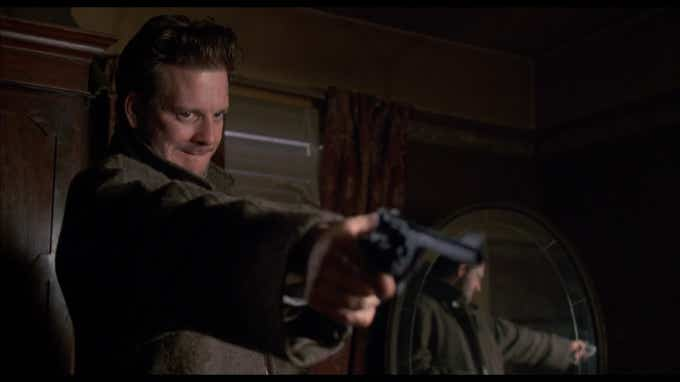
This image is supposed to be Johnny Favorite, in Harry’s body, murdering Dr. Fowler. Is it a memory or a dream?
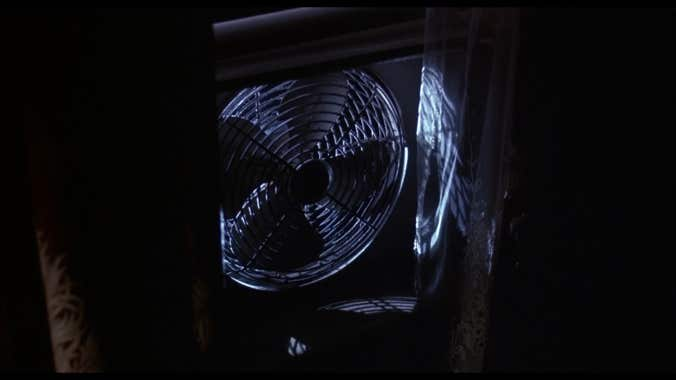
This fan in Dr. Fowler’s bedroom is one of many fans connoting evil, but this fan spins backwards exactly when events would have to play out a second time differently.
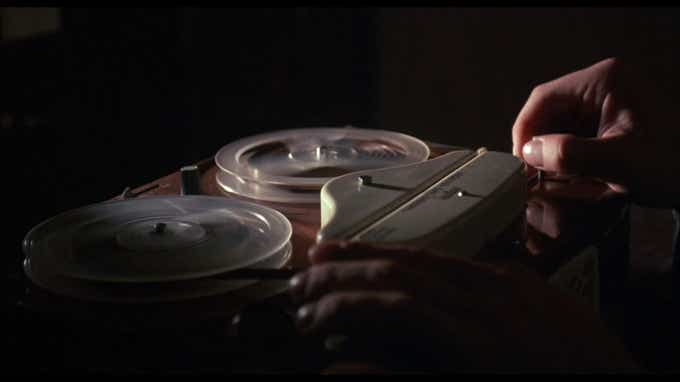
Harry records information for Louis Cyphre, but also rewinds and re-records his voice when he decides to remove incriminating information. Imagine doing this not to a recording, but to reality itself.
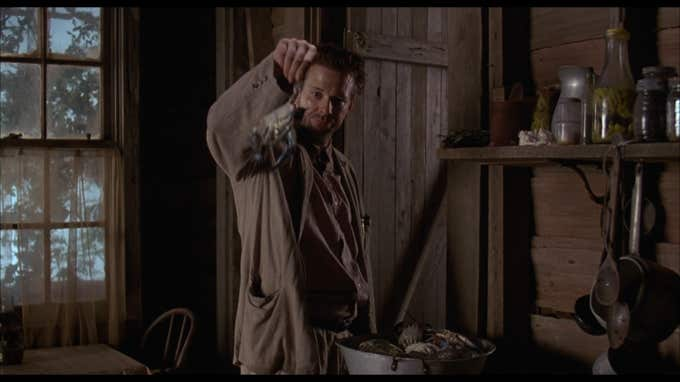
Door #1 is closed and locked and then is open again without anyone unlocking or opening it.
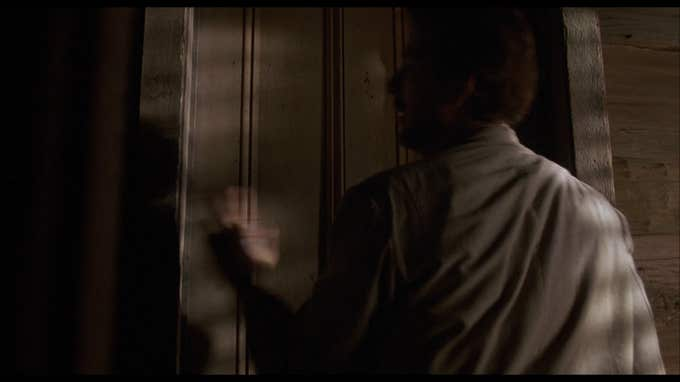
Harry is locked out of the meeting room, even though he unlocked and opened the door. We see an invisible force close it as if time is resetting.
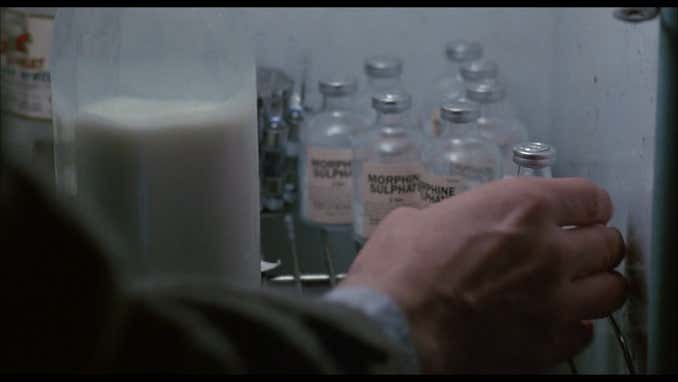
The first time Harry enters Dr. Fowler’s house, he finds milk and an unopened vial of morphine.
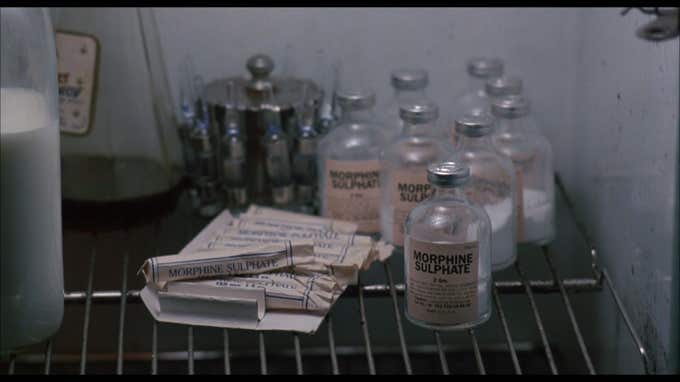
The second time, Harry finds that the milk has not been drunk, but the morphine has been used.
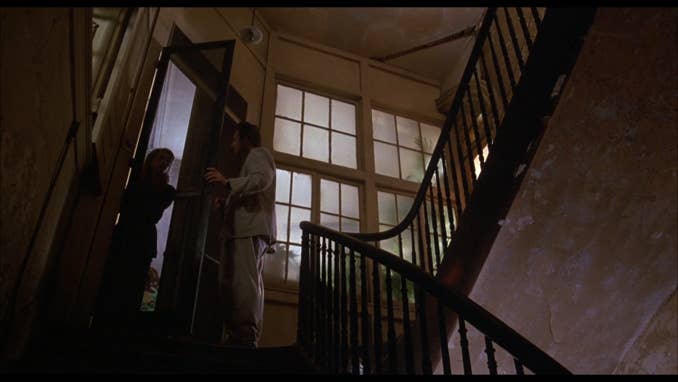
The initial meeting between Harry and Margaret Krusemark, and they are discussing confusion over the time that was scheduled for the appointment.
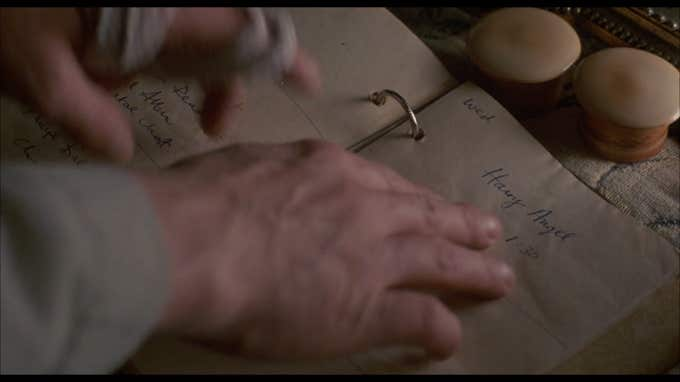
The calendar shows that the appointment with Harry was for 1:30 PM on Wednesday, but for Wednesday today, not last week.


